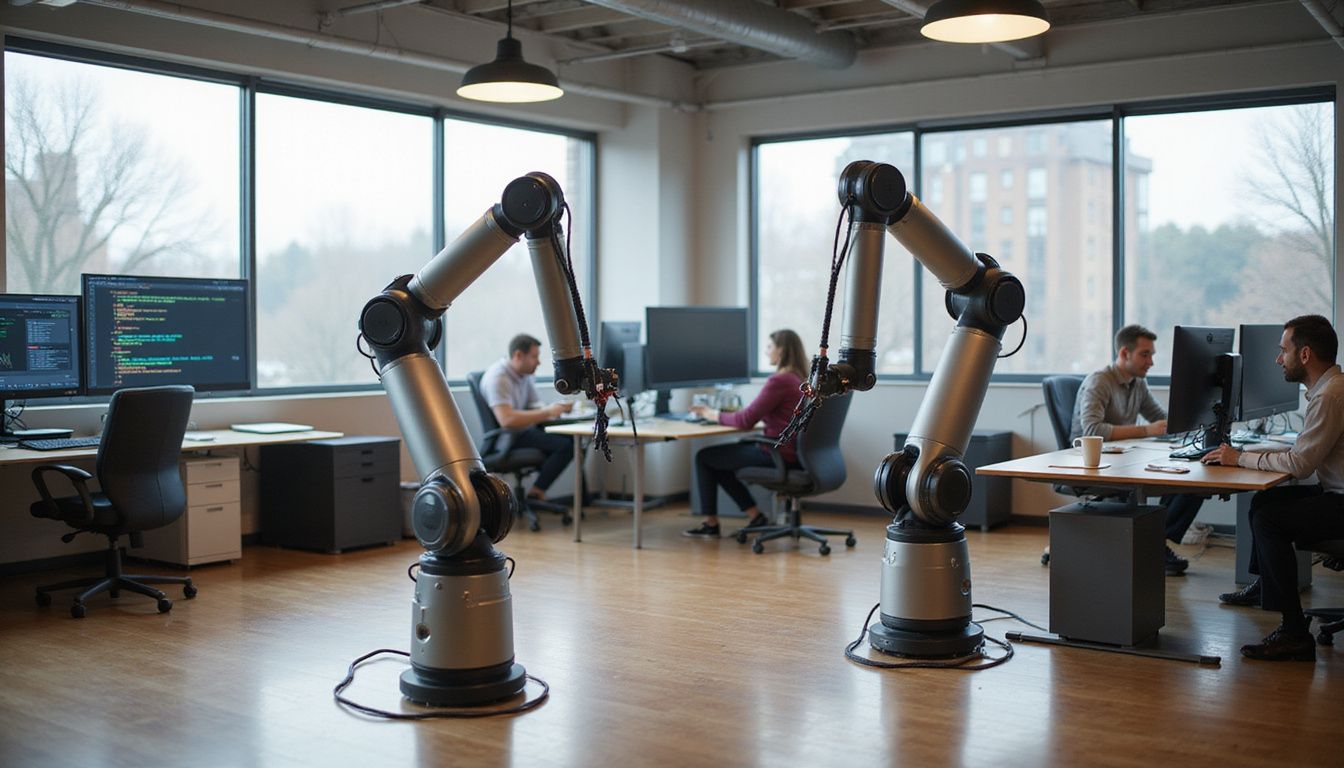Many people make mistakes while doing boring tasks at work. These errors can be costly, slow down business processes, and cause stress for workers. Manual data entry or checking accounts payable often leads to small slips that add up over time.
Robotic process automation (RPA) helps fix this problem. Research shows that automated systems like RPA reduce human error by up to 85%. This blog will show how automating jobs with RPA improves accuracy, cuts costs, and makes tasks faster in different industries using tools like OCR and artificial intelligence.
Find out how your business can become safer and more efficient with fewer mistakes!
What is Robotic Process Automation (RPA)?
Robotic Process Automation, or RPA, uses software robots to copy how humans handle digital tasks. These bots can work with databases and tools like optical character recognition to automate actions in finance, customer service, and data management.
Software robots follow strict rules to complete jobs quickly without getting tired or distracted.
RPA achieves 99.8% accuracy in data entry and cuts errors by up to 95% within six months. McKinsey found that RPA automates up to 42% of financial tasks such as account reconciliation and payment processing.
These bots operate all day which reduces costs and boosts productivity for human resources teams too.
“RPA-powered payment processing operates 24/7, reducing both costs and errors.”
With artificial intelligence tools like machine learning, some systems also adapt over time using learning algorithms for even more precision in error reduction.
Core Mechanisms of RPA in Reducing Human Error

Robotic Process Automation (RPA) cuts down on human mistakes in many ways. It automates tasks that people often do repeatedly, which helps reduce errors. RPA follows clear rules to perform processes correctly.
It also spots and fixes problems immediately, keeping data accurate and reliable.
Automation of Repetitive Tasks

RPA takes over boring and repeated jobs like data entry, invoice processing, and account reconciliation. Bots work non-stop without rest or mistakes. In banking, RPA systems achieve an accuracy rate of 99.8 percent for data entry tasks.
OCR technology boosts this speed further by handling text as fast as 100 times more quickly than a human can. These tools reach up to 99.9 percent correctness in reading documents.
Staff spend less time fixing typing mistakes or finding missing details. Human error drops by up to 95 percent after six months with these automated systems in place. Automated decision-making keeps work steady and follows business rules every time the same task appears.
Rule-based process execution ensures each step gets done exactly right; this helps set the stage for smarter ways to follow strict business policies next.
Rule-Based Process Execution

Robotic process automation uses clear rules to follow steps. This lowers human error in tasks like invoice processing and account reconciliation. Machines stick to the set path every time, so mistakes do not sneak in from skipped or extra steps.
RPA follows key performance indicators and compliance needs with high accuracy.
Supervised learning models can spot errors fast, sometimes reaching 95 percent accuracy rates. These rule-driven bots help meet regulatory compliance during audits and reporting. Large banks use this for fraud detection and fewer data entry mistakes.
The next part explains how real-time error detection makes business even safer from costly slip-ups.
Real-Time Error Detection and Correction

Precise rule-based process execution sets the stage for faster error spotting. Real-time monitoring tools in Robotic Process Automation (RPA) use artificial intelligence and machine learning models to spot mistakes as they happen.
Predictive analytics can catch errors before they get worse, with up to 85-92% accuracy. This helps cut human mistakes by 60-75%. For example, real-time alerts achieve a 50-65% improvement in just one or two weeks.
Real-time systems allow instant detection and correction of data entry inaccuracies.
Entities such as optical character recognition (OCR), anomaly detection algorithms, and automated fraud detection help keep data correct. RPA bots can fix simple faults right away or notify staff at once if action is needed.
These rapid fixes mean better regulatory compliance and higher key performance indicators (KPIs).
RPA Applications Reducing Human Error in Business Operations

RPA helps reduce human error in business tasks. It automates data entry and checks for mistakes. RPA also manages financial data with high accuracy. In supply chains, it keeps track of inventory efficiently. This ensures compliance with regulations seamlessly. This leads to better results for companies every day. Interested in discovering more?
Data Entry and Validation Processes

Automated data entry systems use robotic process automation and optical character recognition to capture and sort large amounts of information. OCR tools reach up to 99.9% accuracy when reading printed or scanned documents, making fewer mistakes than people.
Data entry automation also improves speed in industries like banking, healthcare, and supply chain management.
Validation steps run right after the data enters the system. RPA checks each value against strict rules set for things like format or range errors. These rule-based checks increase accuracy by 70-85% within only two to four weeks of deployment.
Real-time monitoring spots problems at once; this keeps databases clean while supporting strong regulatory compliance and data protection needs across different sectors.
Financial Data Management and Reconciliation

After data entry and validation, RPA tools help with financial data management and reconciliation. Banks use automation for account reconciliation, credit card processing, and loan applications.
Bots process invoices with 99.95% accuracy. This lowers human error in numbers and records.
Entities like UiPath use machine learning systems to match transactions in real time. RPA supports regulatory compliance by checking every detail against rules set out by regulators.
“Every transaction is checked; mistakes drop fast,” says a specialist at Blue Prism. By scaling up processes, software bots handle thousands of entries each day without getting tired or making fatigue-based errors.
Financial services depend on RPA for timely reporting tasks as well as fraud detection and prevention using predictive analytics. These smart systems work across legacy systems, supporting both cloud computing adoption and innovation in account management.
Supply Chain and Inventory Oversight

Moving from account reconciliation to supply chain and inventory oversight, robotic process automation also helps track goods and supplies. RPA uses real-time monitoring with IoT sensors to log every stock movement.
This reduces human error by up to 85 percent and improves efficiency by 15 percent across the supply chain. Predictive analytics finds patterns in inventory changes, which can lower mistakes in stock counts by spotting risks early.
Machine learning algorithms forecast demand and alert staff before shortages or overstocking happens. Optical character recognition checks shipping documents for errors before they slow down deliveries.
In smart factory setups, quality control powered by RPA achieves 99.7 percent accuracy with a 90 percent drop in problems during inspections. These tools help companies scale up their processes while keeping data accurate for better strategic decision-making and regulatory compliance.
Compliance and Regulatory Reporting

Robotic process automation (RPA) brings 99.8% accuracy to compliance checks and regulatory reporting. Software robots follow strict rules for each task. This helps meet regulatory compliance fast and with fewer mistakes than manual work.
RPA can scale up quickly to cover more data or new laws.
Businesses cut costs by 60-75% using RPA in these reports. AI-powered tools like machine learning spot errors right away and fix them before submitting reports. Predictive analytics also flags risks early, improving fraud detection rates by 95%.
Account reconciliation, loan processing automation, and real-time monitoring make meeting regulations safer and simpler for everyone involved.
Industry-Specific Use Cases of RPA for Error Reduction

RPA helps reduce errors in various industries. In healthcare, it streamlines patient data management and diagnostics. In manufacturing, it ensures quality control and monitors processes effectively.
Financial services use RPA for fraud detection and risk analysis to improve safety. Education benefits too, with accurate administrative tasks and student data handling.
Healthcare: Patient Data Management and Diagnostics

Hospitals use robotic process automation to enter patient data and scan documents with optical character recognition. These tools reduce human error in records and reports. Medical imaging systems that use artificial intelligence reach 94.5% accuracy for cancer detection.
AI-driven medication checkers lower mistakes by 40%. Patient risk stratification platforms help care teams lower patient death rates by up to 25%.
Real-time monitoring spots errors before harm occurs, keeping patients safe. Machine learning supports lab test review and highlights unusual results fast. Tools like predictive analytics flag high-risk patients for early action.
Staff spend less time on manual tasks so they can focus more on care.
AI reduces medical errors, saves lives, and lets clinicians make better choices.
Manufacturing: Quality Control and Process Monitoring

Robotic process automation tracks every stage in manufacturing. It spots mistakes fast and helps correct them right away. Quality control robots achieve 90 percent error reduction with up to 99.7 percent accuracy using real-time monitoring and data entry automation.
These smart systems use predictive analytics for predictive maintenance, which cuts errors by 70 percent and stops machine failure before it starts.
Machine learning checks sensor information from production lines to keep processes running smoothly. Process optimisation lowers mistakes by up to 85 percent through constant updates in process monitoring software.
This means workers spend less time on manual checks and more time on strategic decision-making. RPA also sends alerts about issues so testers can act quickly, helping maintain regulatory compliance with minimal human error.
Financial Services: Fraud Detection and Risk Analysis

Quality control leads to better processes. In financial services, fraud detection plays a key role. RPA technology improves this by spotting issues quickly. It finds 95% more fraudulent transactions than humans can do alone.
The system checks each transaction with 99.95% accuracy, ensuring data quality.
Risk analysis helps in decision-making too. Compliance monitoring achieves 99.8% adherence to regulations, which keeps businesses safe from fines and penalties. With real-time monitoring and predictive analytics, companies reduce human error effectively and maintain trust with customers through strong fraud prevention measures.
Education: Administrative Accuracy and Student Data Processing

The shift from financial services to education highlights the growing need for accuracy in data handling. RPA greatly improves administrative tasks in schools and colleges. It achieves 99.8% accuracy in data entry, cutting down human error significantly.
Schools using RPA see an 80-95% decrease in errors within six months.
The system speeds up processes by 30-70%. This efficiency is crucial for handling student data correctly. AI added to RPA can lower operational mistakes by 60-80% during the first year of use.
Moreover, it helps with compliance by automating reporting and monitoring tasks, reducing risks tied to regulations.
Advanced RPA Technologies Enhancing Accuracy

Advanced RPA uses smart tools to boost accuracy. Machine learning helps systems learn and adapt over time, making processes better. Natural language processing improves how robots understand and interact with humans.
Predictive analytics spots issues before they happen, ensuring smooth operations.
Machine Learning Integration for Adaptive Processes
Machine learning improves RPA by making it smarter. It helps systems learn from data and adapt over time. Supervised learning can predict errors with 90-95% accuracy. This high level of precision reduces mistakes in processes.
Reinforcement learning allows systems to change based on feedback.
Ensemble methods boost reliable predictions even more. They combine multiple models to enhance outcomes. With these tools, businesses can improve their efficiency. Data entry automation and account reconciliation benefit greatly from this technology, resulting in fewer human errors as tasks become more precise and accurate.
Next, we will explore how RPA applications reduce human error in business operations.
Natural Language Processing for Communication Accuracy
Machine learning helps systems learn and adapt. This sets the stage for natural language processing (NLP) in improving communication accuracy. NLP cuts translation errors by 40-60%.
It automates document reviews, ensuring that context is clear and correct.
Businesses use AI-driven personalised marketing to boost sales. These strategies can increase conversion rates by 40-60%. Using NLP makes it easier to understand customer needs. Improved messaging leads to better relationships and more trust in data handling across operations like data entry automation and compliance checks.
Predictive Analytics for Proactive Error Prevention
Natural language processing helps improve communication accuracy. Predictive analytics takes this a step further by preventing errors before they happen. This tool predicts mistakes with 85-92% accuracy.
Businesses can act on these predictions and avoid problems.
In healthcare, patient risk stratification systems are vital. They forecast adverse events 6-24 hours before symptoms show. These insights allow for early intervention, improving patient safety and care outcomes.
With predictive analytics, companies can reduce errors by 60-75% compared to reactive methods. Implementing such technology promotes efficiency and reliability in business operations.
Benefits of Using RPA to Address Human Error

RPA helps businesses run faster and more accurately. It reduces mistakes in data tasks, saving time and money.
Increased Process Efficiency
Increased process efficiency is a key benefit of robotic process automation (RPA). It can improve efficiency by 15%. RPA automates repetitive tasks, allowing employees to focus on more important work.
This saves time and increases productivity.
Quality control with RPA achieves up to a 90% reduction in errors. Enhanced accuracy leads to fewer mistakes in tasks like data entry and account reconciliation. Predictive maintenance also plays a role, cutting downtime by 50%.
These improvements make operations smoother and more reliable for businesses.
Enhanced Data Accuracy and Reliability
RPA boosts data accuracy and reliability. It achieves 99.8% accuracy in data entry tasks, which means fewer mistakes happen. Organisations can trust their information more than ever before.
Optical character recognition (OCR) tools also enhance this process with up to 99.9% accuracy. This level of precision can cut down on costly errors.
With RPA handling transactions, businesses see a processing accuracy rate of 99.95%. Reliable data helps improve decision-making and ensures regulatory compliance across operations.
The focus now shifts to how RPA applies to various business functions for error reduction.
Cost Reduction from Error Minimisation
Cost reduction happens when errors are cut down. Automated systems help businesses save money. For example, RPA can help reduce costs by 60-75% in compliance monitoring. Companies save an average of £2.3 million a year through AI and error reduction.
Less human error means more accurate data too. Errors in payment processing decrease with RPA solutions, which cuts costs further. Data entry automation ensures that details are correct from the start.
Accurate processes lead to better strategic decision-making and employee satisfaction as well.
Challenges exist in making these systems work smoothly, but the benefits show strong promise for many industries.
Challenges in Implementing RPA for Error Reduction

Implementing RPA for error reduction comes with its own set of hurdles. Choosing the right tasks for automation can be tricky. Existing systems may not always work well with new tools like RPA and machine learning.
Keeping everything running smoothly also requires regular updates and maintenance. These challenges can affect how well a business uses robotic process automation. For more insights on overcoming these challenges, keep reading!
Selection of Suitable Processes for Automation
Choosing the right tasks for automation is crucial. Not every job fits well with robotic process automation (RPA). Focus on repetitive and rule-based tasks. These include data entry, account reconciliation, and loan processing automation.
McKinsey shows that RPA can automate up to 42% of financial tasks.
Some processes cause frequent human errors. Selecting these will lead to better results when using RPA. Pilot programs can cut errors by 40-60% within just 30-60 days. This quick return helps businesses see the value of automating specific processes right away.
Integration with Existing Systems
Integrating RPA with existing systems can be hard. Many businesses still use legacy systems, which often do not work well with new technology. This makes it tough to implement automation smoothly.
Employee training is key to overcoming this challenge. Training helps workers adapt and reduces disruptions during the switch.
Phased rollouts also make a difference. Implementing RPA in stages allows teams to learn as they go. Cloud-based RPA services offer scalable solutions for HR process automation, making integration easier and more efficient over time.
Maintenance and Updates for Continuous Improvement
Maintenance and updates are essential to keeping RPA systems operating well. Regular checks help identify issues before they escalate into significant problems. Continuous monitoring ensures that processes operate smoothly over time.
This leads to a reduction in errors by 60-90%. It also helps speed up tasks by 30-70%. Updates can include new technology like machine learning or natural language processing, which keep the system current and efficient.
Keeping track of performance metrics is crucial too. Systems must adapt to changes in regulations and business needs. Adjustments based on real-time monitoring encourage improvement.
This way, businesses remain compliant and decrease human error effectively while enhancing productivity.
Conclusion

RPA is a powerful tool for reducing human errors. It automates repetitive tasks, checks rules, and spots mistakes quickly. Businesses can save time and money by using it in data entry and finance.
This leads to more accurate results and better decision-making. Embracing RPA boosts efficiency and enhances employee satisfaction; explore this technology today to discover its benefits!



.svg)










